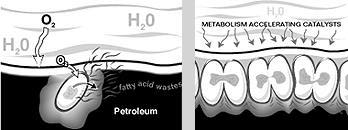Basic Bioremediation Concepts

Bioremediation is the process of using living organisms to break down the
molecular structure of petroleum into less complex substances that are not hazardous
or regulated. In effect, inoculations of hydrocarbon-oxidizing bacteria are
used to turn the physical matrix of contaminated water or soil into a seething
biochemical factory where petroleum is systematically destroyed.
The basic procedure has two parts:
1.) Dense concentrations of hydrocarbon-eating microbes are blended with
special nutrients, biological catalysts and water that is mixed into petroleum-contaminated
soil or water. The microbes bond to petroleum molecules and begin exuding enzymes
that break down those hydrocarbon structures into more water soluble, digestible
materials that are subsequently absorbed through the cell wall and digested
further (above, left). The microbes constantly extract oxygen from the surrounding
water to sustain this intense biochemical activity. In the same way that human
bodies convert hamburgers into new flesh and feces, the microbes continuously
convert hydrocarbon into the protoplasm of new microbes, carbon dioxide and
organic fatty acids. This last is a non-hazardous, fertilizer-like material
that serves as a food source for a wide range of other lower plant and animal
life forms.
2.) The nutrients and biological catalysts mixed with the microbes hyper-accelerate
the organisms' rate of reproduction and digestion (above, right). When properly
applied and managed, the bioremediation materials continue to manufacture themselves
throughout the contaminated soil or water increasing the overall biomass of
microorganisms in an exponential manner until the available hydrocarbons are
consumed. When the hydrocarbons are depleted, the microbes die off for lack
of nutrients.
The end result is that the soil or water that was previously polluted with
petroleum is now laced with a non-regulated fertilizer-like substance that continues
to rapidly decompose as it is consumed by other native organisms in the soil
or water.
There is nothing really new or startling about this biological mechanism
of microbial hydrocarbon conversion; it's as old as life on Earth itself. Over
the eons, many kinds of hydrocarbon-eating, one-celled organisms evolved in
surface soil habitats soaked by petroleum oozing up from underground deposits.
Other similar organisms evolved in areas where plant-generated hydrocarbons--such
as the turpentine-rich resin of certain types of pine trees--were plentiful.
These microbes all developed methods for converting the rich local supply of
hydrocarbons into a food source.
Today, dozens of species of hydrocarbon-eating microorganisms can be found
in soils in many sites around the world. However, the size and action of these
natural microbe colonies is small and very slow. It can take decades for them
to degrade a substantial quantity of petroleum when such a spill happens to
occur in areas where they are present.
In the 1960s microbiologists began to seriously explore the possibility that
some species of these naturally occurring organisms might be concentrated, biologically
accelerated and used to help clean up beaches that were being polluted by oil
from damaged or wrecked oil tanker ships. By the 1980s, a series of microbiological
breakthroughs had allowed scientists to isolate, mass produce and speed up the
metabolic functions of hydrocarbon-eating microbes in a well controlled industrial
process. Like race horses naturally bred to enhance every aspect of their structure
related to speed, the microbes were naturally bred to enhance every aspect of
their metabolism related to the oxidation of hydrocarbon molecules.
At the same time, more than a dozen different types of microbes--each of
which attacks a different kind of hydrocarbon compound--were blended together
to create mixes that can effectively break down (or co-metabolize) a broad range
of petroleum-based contaminants from heavy crude oil to light gasoline.
By the late 1980s these microbe materials gave rise to the first forms of
bioremediation that proved practical and effective in actual field use.
